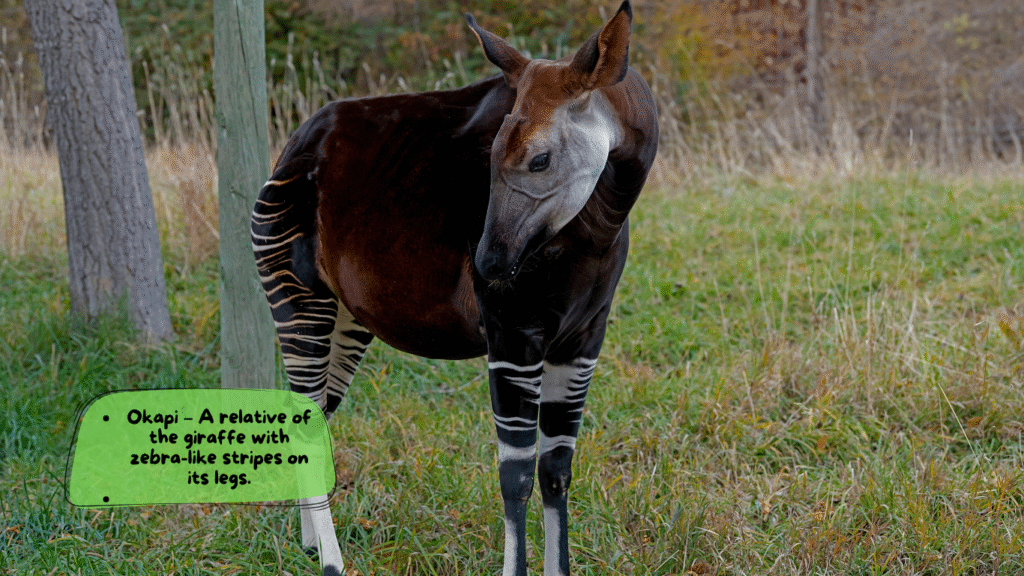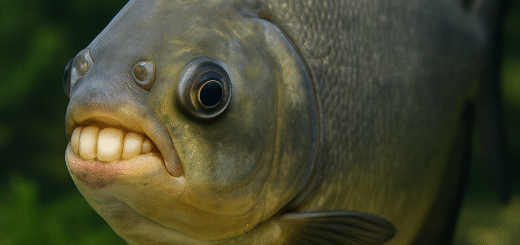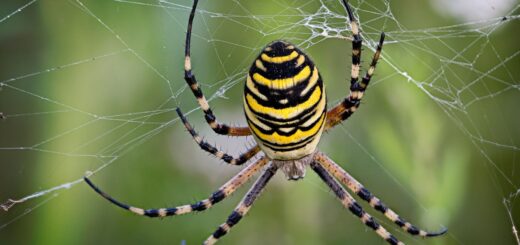The Okapi: A Unique and Enigmatic Creature of the Congo
The Okapi (Okapia johnstoni) is one of the most fascinating and mysterious animals on Earth. With its striking appearance and elusive nature, the okapi has intrigued scientists and wildlife enthusiasts alike. Often referred to as the “forest giraffe” due to its resemblance to its more famous relative, the giraffe, the okapi is a creature native to the dense rainforests of central Africa. However, despite its resemblance to the giraffe, it is not as widely known, making it a truly unique and enigmatic species in the animal kingdom.

Physical Appearance of the Okapi
The okapi is a medium-sized herbivorous mammal with a body that exhibits a remarkable combination of features. Standing about 4.5 to 5 feet tall at the shoulder, it has a long neck and legs similar to a giraffe, yet the body is much shorter and stockier. Its coat is a rich, velvety brown with distinctive white horizontal stripes on its hind legs and rump, which resemble those of a zebra. These striped patterns help camouflage the okapi in its forested habitat, making it an expert at blending into its environment.
Unlike giraffes, the okapi has a much shorter neck, though it still possesses the ability to reach high foliage thanks to its long, flexible tongue. Its tongue, which can extend up to 18 inches, is a critical tool for feeding, as it is used to grasp leaves, fruits, and twigs from trees. The okapi also has large, expressive ears, which help it detect sounds in its forest home.
Habitat and Distribution
The okapi is endemic to the dense rainforests of the Democratic Republic of the Congo (DRC) in central Africa. It is primarily found in the Ituri Forest, a vast tropical rainforest that spans much of the northeastern part of the DRC. The forest is rich in biodiversity and offers the perfect environment for the elusive okapi, with thick vegetation and a complex network of trees that provides both food and shelter.
Due to its secluded habitat, the okapi has remained relatively unknown to the outside world until relatively recently. In fact, the okapi was not discovered by the Western world until the early 20th century. The first European to encounter an okapi was Sir Harry Johnston, a British explorer, in 1901. The species was officially described in 1903.
Behavior and Diet
The okapi is a solitary and nocturnal animal, primarily active during the twilight hours of dawn and dusk. It is a shy and elusive creature that uses its keen sense of hearing and smell to detect predators and other threats. The okapi’s natural predators include leopards, although its ability to blend into the environment and remain hidden in dense forest vegetation provides it with some level of protection.
In terms of diet, the okapi is an herbivore, feeding primarily on leaves, fruits, twigs, and ferns. It is known to be quite selective in its feeding habits, preferring certain plant species over others. The okapi’s tongue plays a vital role in its feeding, as it can strip leaves from branches with precision and ease. Interestingly, it is known to have a specialized digestive system that allows it to break down tough plant materials.
Conservation Status
The okapi is currently classified as Endangered by the International Union for Conservation of Nature (IUCN), with an estimated population of fewer than 50,000 individuals remaining in the wild. The primary threats to the okapi’s survival include habitat loss due to logging and human encroachment, as well as poaching for its meat and skin. The civil unrest and instability in the DRC have also posed challenges for conservation efforts.
Efforts to protect the okapi and its habitat have been underway for several decades. The Okapi Wildlife Reserve, established in 1992, is a UNESCO World Heritage site dedicated to the conservation of the okapi and its surrounding ecosystem. This reserve provides a safe haven for the okapi, helping to ensure that this incredible species does not face extinction.
The Okapi’s Role in Ecosystem and Culture
The okapi plays an important role in its ecosystem as a herbivore. By feeding on various plant species, the okapi helps control vegetation growth and promotes biodiversity in the forest. Its presence in the ecosystem contributes to the balance of species in the rainforests of the Congo Basin.
Culturally, the okapi holds significance for local communities in the Congo. It is a symbol of the wilderness and natural beauty of the region. In some cultures, the okapi is considered a mystical creature, and its rarity and elusive nature have inspired numerous local myths and legends.
Fascinating Facts About the Okapi
- Giraffe Connection: Despite its zebra-like stripes, the okapi is actually more closely related to the giraffe than the zebra. Both animals share a common ancestor, and their similarities are a result of convergent evolution.
- Silent Communication: The okapi communicates with other okapis through scents and body language rather than vocalizations, which adds to its mysterious nature.
- Unusual Diet: The okapi has been known to occasionally eat clay and soil to supplement its diet, possibly to obtain minerals that are lacking in its regular plant-based diet.
- Adapted to Forest Life: The okapi has adapted well to life in dense forests. Its long legs and neck help it navigate through thick underbrush, while its strong sense of smell helps it avoid predators.
Conclusion
The okapi is a remarkable and mysterious creature that continues to captivate the imagination of researchers and wildlife enthusiasts alike. Its unique blend of giraffe-like and zebra-like features, coupled with its elusive nature and vital role in the Congo’s rainforest ecosystem, make the okapi a true marvel of the animal kingdom. As efforts to conserve its population continue, the okapi serves as a symbol of the importance of protecting the world’s most remote and ecologically rich regions.
By learning more about the okapi and supporting conservation efforts, we can help ensure that this enigmatic animal remains a part of our world for generations to come.








